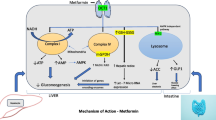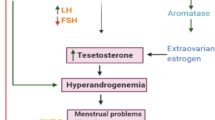Abstract
Polycystic ovary syndrome (PCOS) is commonly characterised by obesity, insulin resistance (IR), hyperandrogenemia and hirsutism. Nesfatin-1 a recently discovered hormone, acts upon energy balance, glucose metabolism, obesity and probably gonadal functions. This study was to evaluate the circulating levels of nesfatin-1 in patients with PCOS (n = 30) and in age and body mass index (BMI)-matched controls (n = 30). PCOS patients had significantly lower levels of nesfatin-1 (0.88 ± 0.36 ng/mL) than healthy controls (2.22 ± 1.14 ng/mL). PCOS patients also had higher gonadotropin and androgen plasma concentrations, Ferriman–Gallwey scores, blood glucose levels and a homeostasis model of assessment-IR index (HOMA-IR) index than in healthy women. Correlation tests in PCOS subjects detected a negative correlation between nesfatin-1 levels and BMI, fasting blood glucose, insulin levels and a HOMA-IR index. Lower nesfatin-1 concentration may plays a very important role in the development of PCOS.
Similar content being viewed by others
Abbreviations
- 17-Αhp:
-
17 Alpha hydroxyprogesterone
- AS:
-
Androstenedione
- BMI:
-
Body mass index
- CSF:
-
Cerebrospinal fluid
- CV:
-
Coefficient of variance
- DHEA-S:
-
Dehydroepiandrosterone sulphate
- DM:
-
Diabetes mellitus
- E2 :
-
Estradiol
- EDTA:
-
Ethylenediaminetetraacetic acid
- FABP4:
-
Fatty acid binding protein
- FBG:
-
Fasting blood glucose
- FG:
-
Ferriman–Gallwey
- FSH:
-
Follicle-stimulating hormone
- FSI:
-
Fasting serum insulin
- HDL:
-
High density lipoprotein
- HOMA-IR:
-
Homeostasis model of assessment-insulin resistance index
- IGF-1:
-
Insulin-like growth factor
- IR:
-
Insulin resistance
- KIU:
-
Kallikrein inactivation unit
- LDL:
-
Low density lipoprotein
- LH:
-
Luteinizing hormone
- LMD:
-
Last menstrual date
- PCOS:
-
Polycystic ovary syndrome
- PRL:
-
Prolactin
- SHBG:
-
Sex-hormone binding globulin
- TSH:
-
Thyroid-stimulating hormone
- TT:
-
Total testosterone
- VLDL:
-
Very low density lipoprotein
- WHR:
-
Waist-hip circumference ratio
References
L. Speroff, Anovulation and polycystic ovary. In Clinical Gynecologic Endocrinology and Infertility, eds. by L. Speroff, M.A. Fritz MA, 6th edn. (Lippincott Williams and Wilkins, Philadelphia, 2005), pp. 465–491
Z.E. Hopkinson, N. Sattar, R. Fleming, I.A. Greer, Polycystic ovarian syndrome: the metabolic syndrome comes to gynecology. BMJ 317, 329–332 (1998)
R. Azziz, K.S. Woods, R. Reyna, T.J. Key, E.S. Knochenhauer, B.O. Yildiz, The prevalence and feature of the polycystic ovary syndrome in an unselected population. J. Clin. Endocrinol. Metab. 89, 2745–2749 (2004)
The Rotterdam ESHRE/ASRM-Sponsored PCOS consensus workshop group, revised consensus on diagnostic criteria and longterm health risks related to polycystic ovary syndrome (PCOS). Hum. Reprod. 19, 41–47 (2004)
D.A. Ehrmann, Polycystic ovary syndrome. N. Engl. J. Med. 352, 1223–1236 (2005)
H.J. Teede, S.K. Hutchison, S. Zoungas, The management of insulin resistance in polycystic ovary syndrome. Trends Endocrinol. Metab. 18, 273–279 (2007)
R. Hamburg, Management of polycystic ovary syndrome in adolescence. Rev. Gynecol. Pract. 4, 148–155 (2004)
H. Jia, L. Yu, X. Guo, W. Gao, Z. Jiang, Associations of adiponectin gene polymorphisms with polycystic ovary syndrome: a meta-analysis. Endocrine. (2012, in press)
B. Dilbaz, E. Ozkaya, M. Cinar, E. Cakir, S. Dilbaz, Cardiovascular disease risk characteristics of the main polycystic ovary syndrome phenotypes. Endocrine 39, 272–277 (2011)
W. Hu, J. Qiao, Expression and regulation of adipocyte fatty acid binding protein in granulosa cells and its relation with clinical characteristics of polycystic ovary syndrome. Endocrine 40, 196–202 (2011)
S. Palomba, A. Falbo, T. Russo, A. Tolino, F. Orio, F. Zullo, Pregnancy in women with polycystic ovary syndrome: the effect of different phenotypes and features on obstetric and neonatal outcomes. Fertil. Steril. 94, 1805–1811 (2010)
I. Oh, H. Shimizu, T. Satoh, S. Okada, S. Adachi, K. Inoue, H. Eguchi, M. Yamamoto, T. Imaki, K. Hashimoto, T. Tsuchiya, T. Monden, K. Horiguchi, M. Yamada, M. Mori, Identification of nesfatin-1 as a satiety molecule in the hypothalamus. Nature 443, 709–712 (2006)
D. García-Galiano, V.M. Navarro, J. Roa, F. Ruiz-Pino, M.A. Sánchez-Garrido, R. Pineda, J.M. Castellano, M. Romero, E. Aguilar, F. Gaytán, C. Diéguez, L. Pinilla, M. Tena-Sempere, The anorexigenic europeptide, nesfatin-1, is indispensable for normal puberty onset in the female rat. J. Neurosci. 30, 7783–7792 (2010)
Y. Su, J. Zhang, Y. Tang, F. Bi, J.N. Liu, The novel function of nesfatin-1: anti-hyperglycemia. Biochem. Biophys. Res. Commun. 391, 1039–1042 (2010)
Q.C. Li, H.Y. Wang, X. Chen, H.Z. Guan, Z.Y. Jiang, Fasting plasma levels of nesfatin-1 in patients with type 1 and type 2 diabetes mellitus and the nutrient-related fluctuation of nesfatin-1 level in normal humans. Regul. Pept. 159, 72–77 (2010)
S. Aydin, The presence of the peptides apelin, ghrelin and nesfatin-1 in the human breast milk, and the lowering of their levels in patients with gestational diabetes mellitus. Peptides 31, 2236–2240 (2010)
M. Aslan, O. Celik, N. Celik, I. Turkcuoglu, E. Yilmaz, A. Karaer, Y. Simsek, E. Celik, S. Aydin, Cord blood nesfatin-1 and apelin-36 levels in gestational diabetes mellitus. Endocrine. (2011, in press)
E. Carmina, A.M. Campagna, R.A. Lobo, A 20-year follow-up of young women with polycystic ovary syndrome. Obstet. Gynecol. 119, 263–269 (2012)
D. Dewailly, P. Pigny, B. Soudan, S. Catteau-Jonard, C. Decanter, E. Poncelet, A. Duhamel, Reconciling the definitions of polycystic ovary syndrome: the ovarian follicle number and serum anti-Müllerian hormone concentrations aggregate with the markers of hyperandrogenism. J. Clin. Endocrinol. Metab. 95, 4399–4405 (2010)
D. Dewailly, H. Gronier, E. Poncelet, G. Robin, M. Leroy, P. Pigny, A. Duhamel, S. Catteau-Jonard, Diagnosis of polycystic ovary syndrome (PCOS): revisiting the threshold values of follicle count on ultrasound and of the serum AMH level for the definition of polycystic ovaries. Hum. Reprod. 26, 3123–3129 (2011)
S. Aydin, Discovery of ghrelin hormone: research and clinical applications. Turk. J. Biochem. 32, 76–89 (2007)
L. Ibanez, N. Potau, A. Carrascosa, Insulin resistance, premature adrenarche and a risk of the PCOS. Trends Endocrinol. Metab. 9, 72–77 (1998)
F. Ovalle, R. Azziz, Insulin resistance, polycystic ovary syndrome and type 2 diabetes mellitus. Fertil. Steril. 77, 1095–1105 (2002)
J. Kusari, Y. Takata, E. Hatada, G. Freidenberg, O. Kolterman, J.M. Olefsky, Insulin resistance and diabetes due to different mutations in the tyrosine kinase domain of both insulin receptor gene alleles. J. Biol. Chem. 266, 5260–5267 (1991)
A. Dunaif, Insulin resistance and the polycystic ovary syndrome: mechanism and implications for pathogenesis. Endocr. Rev. 18, 774–800 (1997)
B.O. Yildiz, O. Gedik, Assessment of glucose intolerance and insulin sensitivity in polycystic ovary syndrome. Reprod. Biomed. Online 8, 649–656 (2004)
A.M. Venkatesan, A. Dunaif, A. Corbould, Insulin resistance in polycystic ovary syndrome: progress and paradoxes. Recent Prog. Horm. Res. 56, 295–308 (2001)
R. Gonzalez, A. Tiwari, S. Unniappan, Pancreatic beta cells colocalize insulin and pronesfatin immunoreactivity in rodents. Biochem. Biophys. Res. Commun. 381, 643–648 (2009)
M. Nakata, K. Manaka, S. Yamamoto, M. Mori, T. Yada, Nesfatin-1 enhances glucose-induced insulin secretion by promoting Ca(2+) influx through L-type channels in mouse islet β-cells. Endocr. J. 58, 305–313 (2011)
V.L. Nelson, K.N. Qin, R.L. Rosenfield, J.R. Wood, T.M. Penning, R.S. Legro, J.F. Strauss III, J.M. McAllister, The biochemical basis for increased testosterone production in theca cells propagated from patients with polycystic ovary syndrome. J. Clin. Endocrinol. Metab. 86, 5925–5933 (2001)
R. Nahum, K.J. Thong, S.G. Hillier, Metabolic regulation of androgen production by human thecal cells in vitro. Hum. Reprod. 10, 75–81 (1995)
H. Shimizu, S. Oh, S. Okada, M. Mori, Nesfatin-1: an overview and future clinical application. Endocr. J. 56, 537–543 (2009)
D.S. Guzick, R. Wing, D. Smith, S.L. Berga, S.J. Winters, Endocrine consequences of weight loss in obese, hyperandrogenic, anovulatory women. Fertil. Steril. 61, 598–604 (1994)
R.J. Norman, M.J. Davies, J. Lord, L.J. Moran, The role of lifestyle modification in polycystic ovary syndrome. Trends Endocrinol. Metab. 13, 251–257 (2002)
B.K. Tan, M. Hallschmid, W. Kern, H. Lehnert, H.S. Randeva, Decreased cerebrospinal fluid/plasma ratio of the novel satiety molecule, nesfatin-1/NUCB-2, in obese humans: evidence of nesfatin-1/NUCB-2 resistance and implications for obesity treatment. J. Clin. Endocrinol. Metab. 96, E669–E673 (2011)
M. Ari, O.H. Ozturk, Y. Bez, S. Oktar, D. Erduran, High plasma nesfatin-1 level in patients with major depressive disorder. Prog. Neuropsychopharmacol. Biol. Psychiatry 35, 497–500 (2011)
M. Ramanjaneya, J. Chen, J.E. Brown, G. Tripathi, M. Hallschmid, S. Patel, W. Kern, E.W. Hillhouse, H. Lehnert, B.K. Tan, H.S. Randeva, Identification of nesfatin-1 in human and murine adipose tissue: a novel depot-specific adipokine with increased levels in obesity. Endocrinology 151, 3169–3180 (2010)
Z. Zhang, L. Li, M. Yang, H. Liu, G. Boden, G. Yang, Increased plasma levels of nesfatin-1 in patients with newly diagnosed type 2 diabetes mellitus. Exp. Clin. Endocrinol. Diabetes 120, 91–95 (2012)
Acknowledgments
The authors like to extend their thanks to FUBAP for their financial support (project number 1889). And also their heartfelt thanks and never ending admiration to Harry Miller for his editing this manuscript.
Conflict of interest
The authors declare that they have no conflict of interest.
Author information
Authors and Affiliations
Corresponding author
Rights and permissions
About this article
Cite this article
Deniz, R., Gurates, B., Aydin, S. et al. Nesfatin-1 and other hormone alterations in polycystic ovary syndrome. Endocrine 42, 694–699 (2012). https://doi.org/10.1007/s12020-012-9638-7
Received:
Accepted:
Published:
Issue Date:
DOI: https://doi.org/10.1007/s12020-012-9638-7




